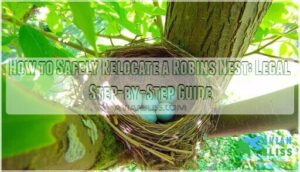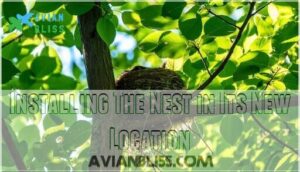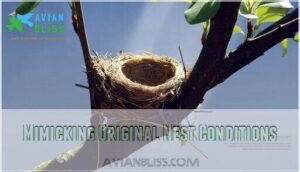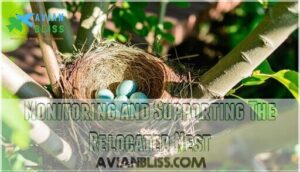This site is supported by our readers. We may earn a commission, at no cost to you, if you purchase through links.

If relocation is permitted, work with a wildlife rehabilitator to carefully move the nest, handle eggs gently, and secure it in a similar location. Monitor parent birds for acceptance after the move.
The key is understanding when relocation is truly necessary versus exploring alternatives like barriers. Proper timing, technique, and legal compliance determine whether relocated robins will thrive in their new home.
Table Of Contents
- Key Takeaways
- Can You Legally Move a Robin’s Nest?
- When Should a Robin’s Nest Be Relocated?
- Preparing for Safe Robin Nest Relocation
- Step-by-Step Guide to Moving a Robin’s Nest
- Monitoring and Supporting The Relocated Nest
- Frequently Asked Questions (FAQs)
- Will a robin find its nest if it’s moved?
- Is it legal to move a robin’s nest?
- Where to relocate a robin’s nest?
- What to do if a robin builds a nest on your porch?
- Can robins recognize humans and adjust to their presence?
- Do robins leave their eggs unattended during incubation periods?
- How do robins respond to disturbed or moved nests?
- What happens when a robins mate is killed during nesting?
- Can a robins nest be safely moved to a nearby tree?
- What happens if relocated nest gets abandoned?
- Conclusion
Key Takeaways
- You can’t legally move an active robin’s nest without federal permits – the Migratory Bird Treaty Act protects these birds and violations carry fines up to $15,000 plus potential jail time.
- You’ll need to work with a registered wildlife rehabilitator who has proper permits and expertise to handle the relocation safely while following all legal requirements.
- Moving a nest often causes parents to abandon it entirely, so you should explore alternatives like barriers or deterrents before considering relocation as a last resort.
- If relocation becomes necessary, you must work quickly, handle eggs and nestlings with extreme care, and place the nest within 50 feet of the original location with similar conditions for the best chance of success.
Can You Legally Move a Robin’s Nest?
You can’t legally move a robin’s nest without following federal and state regulations that protect these birds. The Migratory Bird Treaty Act requires permits from wildlife authorities before relocating any nest, especially those containing eggs or chicks.
Migratory Bird Treaty Act Regulations
You can’t legally relocate a robins nest without following strict Migratory Bird Treaty Act regulations. The MBTA protects robins from nest destruction and requires permit acquisition for any relocation involving eggs or nestlings, with serious enforcement penalties awaiting violators.
- MBTA Compliance: Federal law prohibits disturbing their reproduction without proper authorization
- Permit Acquisition: Wildlife rehabilitation laws require permits from U.S. Fish and Wildlife Service
- Nest Destruction: Moving active nests is illegal and carries heavy fines
- Enforcement Penalties: Violations can result in $15,000 fines and jail time
- Legal Loopholes: Only inactive, abandoned nests may sometimes be moved without permits
State and Local Wildlife Laws
Beyond federal protections, you’ll encounter additional state and local wildlife laws that often provide stricter regulations than the Migratory Bird Treaty Act. Most states classify robins as protected species, requiring permits from local registered wildlife rehabilitators before you can relocate the nest.
Local ordinances may impose enforcement penalties for disturbing their reproduction, even without eggs present. Habitat preservation laws vary by municipality, making citizen reporting to wildlife rehabilitation authorities your safest approach.
Emergency Situations and Permit Requirements
State and local regulations add another layer, but sometimes you face immediate danger that can’t wait. If your robin nest poses safety risks like fire hazards or structural collapse, emergency relocation permits become your lifeline.
- Contact your local registered wildlife rehabilitator first for emergency guidance
- Document the immediate danger with photos and detailed descriptions
- Apply for federal permits through the U.S. Fish and Wildlife Service
- Follow specific safety protocols during the nest move
- Report outcomes to wildlife authorities for legal compliance
Penalties for Unauthorized Relocation
Breaking the Migratory Bird Treaty Act carries serious consequences. Federal fines reach up to $15,000, with imprisonment risks of up to six months. State penalties vary by location but add additional legal defense costs. Unauthorized bird nest relocation violates wildlife rehabilitation standards and damages public perception of bird conservation efforts.
Violating federal bird protection laws brings fines up to $15,000 and potential jail time for unauthorized nest relocation
Migratory bird protection requires proper permits to avoid these harsh penalties. The Act’s penalty enforcement includes fines and imprisonment for violations.
When Should a Robin’s Nest Be Relocated?
You should consider relocating a robin’s nest when it poses safety risks to humans or birds, blocks essential property access, or faces high predation threats.
Before moving any nest, explore alternative solutions like barriers or deterrents, since relocation can stress birds and may lead to nest abandonment.
Safety Hazards to People and Birds
Moving a robin’s nest becomes necessary when serious safety threats emerge. You’ll face risks from aggressive parent birds defending their territory, while improper handling can expose you to disease transmission or structural damage to nearby property.
- Nest Defense: Parent robins aggressively dive-bomb and attack anyone approaching their nest, potentially causing eye injuries or falls.
- Disease Transmission: Direct contact with bird eggs, nesting materials, or droppings can spread parasites and bacterial infections to humans.
- Environmental Hazards: Nests built on unstable structures, electrical equipment, or high-traffic areas create dangers for both birds and people.
- Structural Integrity: Heavy nests on weak branches, gutters, or building materials may cause property damage when they fall.
Bird nest relocation requires careful handling precautions under Migratory Bird Protection laws to ensure robin safety.
Nest Location and Property Access
Convenience sometimes conflicts with conservation when robins choose nest sites that block your daily routines. If you’re dealing with conspicuous nesting near doorways or frequently used areas, human activity impact becomes a major factor.
Before moving the nest, consider deterrent strategies like temporary barriers. Remember that nest site selection affects nest reusability, so relocate thoughtfully to maintain the bird nest’s integrity.
Risks of Abandonment or Predation
Several critical risks threaten robin families when you relocate their nest. Moving a nest often triggers immediate abandonment by parent birds, leaving eggs and nestlings defenseless. Relocation stress affects habitat security significantly.
- Nest abandonment causes include disrupted landmarks and unfamiliar surroundings
- Predator identification becomes harder in new locations, increasing nestling vulnerability
- Nest predation prevention fails without established territorial boundaries.
Relocating nests can be detrimental, as robins don’t reuse old nests.
Considering Alternative Solutions
Before relocating any bird nest, you should explore alternatives that protect both robins and your property. Install preventative barriers around problem areas or provide nesting boxes in a similar location away from high-traffic zones.
Visual deterrents like reflective tape can redirect robins to better nest sites.
Consider planting native vegetation or creating bird-friendly gardens to attract robins elsewhere naturally.
Preparing for Safe Robin Nest Relocation
Before you attempt to relocate a robin’s nest, you’ll need to contact a registered wildlife rehabilitator who can guide you through the legal requirements and proper techniques.
You should also gather the right tools, including gloves, a small basket or container, and identify a safe new location that matches the original nest’s conditions.
Consulting a Registered Wildlife Rehabilitator
Before attempting any wildlife intervention, you must contact a licensed rehabilitator through your state wildlife department or Animal Help Now. These experts possess specialized permits for bird relocation and understand ethical considerations that protect robin families.
Rehabilitators assess whether relocation alternatives exist and provide essential long-term support throughout the process, ensuring both legal compliance and bird conservation success.
Gathering Tools and Protective Gear
After you’ve received expert guidance, proper Tool Preparation becomes your safety foundation. Essential Equipment for nest handling includes basic items that protect both you and the Wildlife during Robin Nesting Behavior observations.
- Thick work gloves to prevent scratches from bird nesting material
- Long-sleeved shirt and pants as Protective Clothing barriers
- Small cardboard box or basket for temporary nest transport
- Safety Measures like eye protection from defensive parent birds
Selecting a Suitable New Location
Choose your new location carefully to maximize nesting success. Find a spot within 50 feet of the original site to maintain the robins’ territorial comfort. Look for natural tree branches or sturdy structures that mirror the original nest’s height and environment.
| Location Factor | Ideal Conditions |
|---|---|
| Weather Exposure | Partial shade with morning sun |
| Predator Avoidance | 6-8 feet high, away from cat access |
| Nest Stability | Sturdy fork in branches or secure ledge |
| Accessibility Factors | Clear flight path, minimal human traffic |
Creating or Using an Artificial Nest
Sometimes you’ll need to craft an artificial nest when the original becomes damaged during relocation. Start with a small wicker basket or plastic container with drainage holes for your Nest Box Design. Choose natural materials like dried grass, small twigs, and soft moss for Material Selection.
Your Placement Strategies should position the artificial nest securely in branches, mimicking the American Robin’s preference for sturdy support. Robins Nest acceptance improves when you line the container with mud, just like natural nest building.
Proper Maintenance Tips include checking stability and adding Nest Predation Prevention features like thorny branches nearby.
Step-by-Step Guide to Moving a Robin’s Nest
You’ll need to work carefully and systematically when moving a robin’s nest to ensure both your safety and the birds’ survival. The process requires precise timing, proper handling techniques, and close attention to environmental conditions that affect the nest’s success in its new location.
Safely Removing The Nest
Once your professional team arrives, begin nest removal timing carefully. Work quickly but steadily – studies show parent robins can detect handling nest materials within minutes.
Wear gloves and support the entire structure from below to prevent damage. Minimizing stress means moving in slow, deliberate motions without sudden movements. This approach reduces avoiding abandonment risks while ensuring post-removal care starts immediately.
Handling Eggs or Nestlings With Care
During Wildlife relocation, handle eggs with clean, dry hands to prevent contamination. Cradle each egg gently, avoiding pressure or shaking that could harm developing embryos.
For nestlings, maintain body heat by cupping them close to your chest. Limit handling time to reduce stress on these vulnerable birds. Work quickly but deliberately, as American Robin parents may abandon their nest if disturbance lasts too long.
Installing The Nest in Its New Location
Once you’ve carefully handled the eggs or nestlings, place the bird nest securely in your chosen location. The American Robin needs specific conditions during nesting season to accept the relocated nest successfully.
- Nest Stability: Secure the nest between sturdy branches or in a fork, ensuring it won’t shift during wind
- Weather Protection: Position under natural cover like leaves or eaves to shield from rain and direct sun
- Camouflage Techniques: Blend the nest with surrounding vegetation to reduce visibility to predators
- Minimizing Stress: Work quickly and quietly, avoiding unnecessary movements near the installation site
- Post-Install Monitoring: Step back immediately after placement to observe from a distance for parent bird return
Install at the same height as the original location when possible. Birds recognize familiar elevation patterns and will adapt better to similar positioning.
Mimicking Original Nest Conditions
Match the original microclimate conditions by positioning your relocated bird nest at similar heights and sun exposure levels. Robins nest only when temperatures stay between 45 and 65 degrees, so choose a spot with comparable wind protection and shade patterns.
Source similar natural materials from the area to maintain structural integrity and camouflage importance. This careful replication during nesting season helps ensure parental acceptance of the eggs and supports the robin reproduction cycle.
Monitoring and Supporting The Relocated Nest
You’ll need to watch the relocated nest closely for the next few days to see if the parent robins return and accept the new location.
Check the nest from a distance several times daily, looking for signs of parental activity like feeding visits or protective behavior, and be ready to contact your wildlife rehabilitator if the parents don’t return within 24-48 hours.
Observing Parent Bird Behavior
Post-relocation monitoring requires tracking feeding visits every fifteen to twenty minutes during Chick Development. Watch for Abandonment Signs like absent Parental Care beyond one hour, aggressive Nest Defense behaviors, or disrupted Feeding Habits.
Document observations using NestWatch protocols, noting the robin reproduction cycle continues through consistent Bird Nesting activity.
Ensuring Nestling Safety and Comfort
After parent birds accept the relocated nest, you’ll need to monitor nestling safety closely. Check nestling temperature by observing their behavior—huddled chicks indicate cold stress. Maintain predator protection by ensuring the new location stays secure from cats and other threats. Monitor nest sanitation as dirty conditions harm developing birds. Verify food availability by watching parent feeding frequency. Focus on reducing stress through minimal human disturbance during this critical fledging period.
- Temperature regulation – Watch for shivering or panting in nestlings
- Predator barriers – Keep cats, snakes, and climbing animals away
- Clean environment – Remove waste buildup that attracts parasites
- Feeding access – Ensure parents can reach the bird nest easily
- Quiet zones – Limit noise and movement near the nest area
Providing Supplemental Support if Needed
When parents can’t provide adequate care after relocation, you’ll need to step in carefully. Orphaned nestlings require feeding fledglings every hour with mealworms or soaked cat food on a toothpick. Provide hydration support through shallow water dishes and weather protection with heating pads for warmth.
Monitor the bird nest for predator defense by installing barriers. Contact NestWatch volunteers or Wildlife Rehabilitation centers for guidance.
Follow Bird Conservation Tips to prevent egg abandonment during supplemental care efforts.
Documenting and Reporting The Outcome
Record your Post-Relocation Observations in a detailed journal, noting Behavioral Changes and Success Metrics like parent acceptance and nestling health.
Submit findings to NestWatch for broader Bird Conservation Tips and Long-Term Survival research. Your documentation helps scientists understand bird nest relocation outcomes, supporting conservation efforts through shared experiences and data.
Frequently Asked Questions (FAQs)
Will a robin find its nest if it’s moved?
Like a boomerang that won’t return, a moved robin nest rarely brings back its parents. Robins usually abandon relocated nests because they’re deeply attached to their original site choice.
Is it legal to move a robin’s nest?
No, it’s typically illegal to move a robin’s nest. The Migratory Bird Treaty Act prohibits "taking" nests of protected species, and federal permits are required for relocation in extreme circumstances.
Where to relocate a robin’s nest?
Relocate the nest to a nearby tree or shrub within 15 feet of the original spot. Choose dense foliage that mimics nature’s blueprint for protection from predators and weather elements. You’ll want similar height and shelter conditions.
What to do if a robin builds a nest on your porch?
Wait it out and enjoy the experience. Try not to use the area around the nest until the young have fledged to ensure that the parents won’t abandon their nest.
Simply avoid the nest area for several weeks.
Can robins recognize humans and adjust to their presence?
While you might think robins can’t tell people apart, they actually recognize individual humans quite well. These smart birds remember faces and adjust their behavior based on your routine, becoming less alarmed around familiar, non-threatening people over time.
Do robins leave their eggs unattended during incubation periods?
Female robins stay with their eggs about 50 minutes out of every hour during the 12-14 day incubation period.
They leave briefly to find food but return quickly to maintain proper temperature for healthy development.
How do robins respond to disturbed or moved nests?
Robins typically abandon nests that’ve been disturbed or moved, even short distances. You’ll notice they’ll scout new locations rather than return, especially if you’ve handled their carefully constructed home.
What happens when a robins mate is killed during nesting?
When life takes an unexpected turn, you’ll find that if the female robin dies, the eggs won’t survive since males can’t incubate them.
If it was the male who died, the female might continue to incubate, but may just give the nest up for lost.
Can a robins nest be safely moved to a nearby tree?
Yes, you can move a robin’s nest to a nearby tree, but only if it’s empty. Federal law prohibits moving nests with eggs or chicks.
Parents typically abandon relocated nests, so wait until they’re done.
What happens if relocated nest gets abandoned?
Like a house of cards collapsing, parents will most likely abandon the relocated nest, eggs, and young. You’ll find empty eggs and no returning adults.
Consider contacting wildlife rehabilitation professionals for guidance.
Conclusion
Successfully learning how to safely relocate a robins nest requires balancing legal compliance with wildlife welfare. You must obtain proper permits before moving active nests, work with certified rehabilitators, and choose timing carefully.
Prevention often works better than relocation—installing barriers before nesting season protects both birds and property.
When relocation becomes necessary, gentle handling and quick placement in similar conditions give relocated families their best chance at survival.
- https://www.congress.gov/committee-report/111th-congress/senate-report/375/1
- https://journeynorth.org/robins/resources/article/facts-help-robin-expert
- https://www.conservationevidence.com/actions/648
- https://www.backyardchickens.com/threads/rescued-a-baby-robin-now-what-do-i-do.66127/
- https://www.wcnga.org/hatchlings-nestlings













